Intro
The reign of Philippe Auguste and his victorious struggle against the powerful Plantagenets, claimed by the prestigious victory of Bouvines, made it possible to considerably consolidate the power of the Capétiens. France now sees a succession of great kings on its throne. The reign of Louis IX who became Saint Louis is one of the most significant. It is marked mainly by several crusades:two crusades against the Muslims (seventh and eighth) and a bloody crusade against the Albigensians started by his predecessors.
Reigns
The reign of Louis VIII the Lion
Louis VIII is the son of Philippe Auguste and Isabelle de Hainaut. He distinguished himself mainly during the reign of his father, notably by winning the victory of La Roche-aux-Moines against Jean sans Terre. He even nearly obtained the crown of England which the rebellious English barons offered him. Philip II, sure of his power, had not deemed it necessary to consecrate his son during his lifetime, as the previous Capetians had done. History proved that he was right:on his death in 1223, Louis VIII ascended the throne. The new king already has a lot of experience for having reigned alongside his father for a long time. Louis VIII continued the fight against the Plantagenets, capturing Poitou, Saintonge, Angoumois, Périgord and part of Gascony in quick succession. These lightning conquests earned him the nickname "The Lion". In 1226, Louis led a crusade against the Albigensians where a mysterious heresy took root. He lays siege to Avignon, but suddenly dies of dysentery (one speaks of deliberate contamination of water sources). This short three-year reign came to an abrupt end, yet it promised to be promising and radiant.
Louis VIII receiving the submission of Avignon
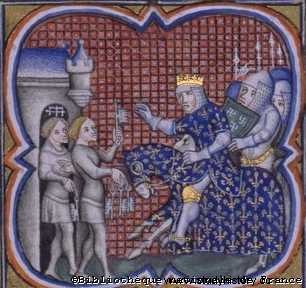
(National Library of France)
White of Castile
It was during the winter of 1200 that Eleanor of Aquitaine (queen of France, then of England), aged 80, escorted her granddaughter Blanche de Castille, aged 12, to the throne of France. where she was promised to the son of Philip II, the young Louis. It is for Aliénor to save the Angevin empire, following the disastrous reign of his son Jean Sans Terre. Louis and Blanche did not know each other when the decision to marry was made, which is not surprising at the time. They first grew close to each other for five years and married in 1205. The marriage was fruitful since more than ten children were born from this union. Louis VIII, ill on his return from his crusade against the Albigensians, had written a will in which he entrusted the government to his wife, until the majority of their son Louis (aged 12). For the first time, the Queen of France would reign over the kingdom, obviously announcing a period of internal turmoil. But that's without counting the great qualities of head of state of the mother of the future Saint Louis.
Coronation of Louis VIII and Blanche of Castile
Louis VIII is the first Capetian king who was not crowned during his father's lifetime.
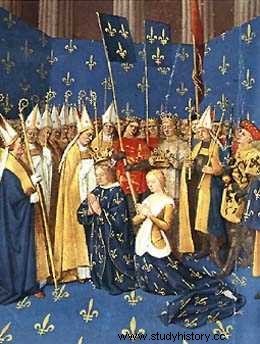
The regency of Blanche of Castile
Energetic and determined, the regent first had to face the revolt of the great barons, led by the Duke of Brittany, the Counts of Champagne and Boulogne. She managed to break this opposition by rallying the Count of Champagne, Thibaud, to the royal cause. She then concluded, to the advantage of the crown, the war against the Albigensians and held the reins of power firmly in her hands until 1242. A cultured and experienced woman, Blanche of Castile knew how to surround herself with a team of loyal advisers who, having assisted the two preceding kings of France, had acquired a wide and profound knowledge of public affairs. She also devoted a large part of her time to the education of the young king, her son, of whom she made an accomplished Christian who was never to forget the religious principles which were then inculcated in him. “My son, she said to him, I like you very much, but I would rather see you dead than guilty of a mortal sin. »
When he came to power, Louis IX was a well-prepared king, closely supervised by his mother. He was also the first king to have known his grandfather, the illustrious Philippe Auguste, who gave him a lot of advice. The Dominicans and Franciscans were numerous around him and exerted a growing influence on his behavior and his policy. Louis IX is thus recognized by his vassals and feared in England.
The reign of Saint Louis
Aware of his duties and anxious to fulfill them without weakness, Saint Louis was also very careful to ensure that his rights were respected. Royal preponderance was not in dispute for him. When in 1242, for the last time, the nobles of the kingdom, supported by the King of England, rose up, he personally went to beat their armies under the walls of the town of Saintes, and took energetic and effective measures against them. . With the dual purpose of being more attentive to the well-being of his subjects and of giving greater solidity to the monarchy, whose domain had grown considerably in less than a century, Saint Louis continued the work of his administrative predecessors. Under his reign, the bailiffs, these itinerant inspectors created by Philippe Auguste, were installed in a fixed circumspection. To monitor them and prevent their excesses, the king had them checked by royal investigators. In 1254, he created a Parliament which became a court of justice and a political council. He does not hesitate to get involved in certain legal decisions and puts an end to God's judgment by ordering investigations and searches for evidence with hearings of witnesses. It also reinforces the royal authority by reducing that of the great feudalism:it imposes its own currency by ordinance and limits the circulation of that of the lords to their only domain. During the summer of 1242, Saint Louis fell seriously ill and, in the midst of his suffering, he took an oath to “take up the cross” if God allowed his healing. The reign of Louis IX is thus marked by two crusades in the Holy Land and the fight against the Cathar heretics. (see the page about the Cathars)
St. Louis
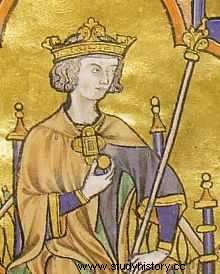
The King's Crusades
The Seventh Crusade (1248 - 1254)
In 1248, the Holy Land was taken over by the infidels:the Sultan of Egypt took over Jerusalem, which had been returned to Westerners following negotiations for the 6th Crusade, and massacred the Frankish army. Louis IX therefore undertakes an expedition to the heart of Egypt in order to attack the Saracens at the heart of their power, hoping to force the sultan to cede Jerusalem. However the religious ardor is less, Louis IX is obliged to force a certain number of its close relations to take the cross with him. He left with his wife Marguerite de Provence and his two brothers, Robert d'Artois and Charles d'Anjou. The king embarks at Aigues-Mortes, a royal port under construction which will allow France to have an outlet on the Mediterranean. After a stopover in Cyprus, the crusaders seize the city of Damietta, then prepare to march on Cairo where the sultan resided. It does not reach its goal, because it was attacked on the way by the Saracens and cut to pieces at Mansourah. The king's brother, Robert d'Artois is killed with many of his knights, the king and the rest of the army are taken prisoner. After negotiation, Louis IX is released against an enormous ransom of 400,000 pounds (paid partially by the Templars). Saint Louis spent another four years in the Holy Land, helping the Frankish principalities to reorganize their defense system. The reinforcements on which he had counted not coming, he ended up returning to France in 1254. It was also the death of his mother, Blanche de Castille, who was in charge of the regency, which will decide Louis to return after six years of absence.
Siege of Damietta
Despite the failure of the crusade, Saint Louis won the respect and consideration of the pope.
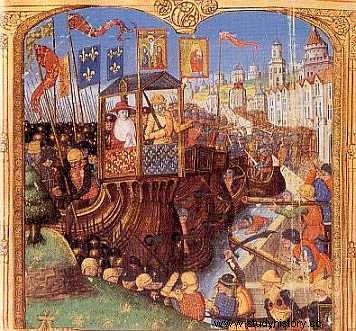
The Eighth Crusade (1270)
The failure of the Seventh Crusade, which Saint Louis interpreted as divine punishment, affected him greatly. Yet in the 13th century, Europe was no longer, as in the 12th century, mobilized against the infidels. As the poet Rutebeuf said:“One can easily win God without moving from one's country, by living from one's heritage. I do no harm to anyone. If I leave, what will become of my wife and children? It will be time to fight when the sultan comes this way. The danger represented by the Muslims had become less pressing:already expelled from Sicily, they were methodically driven back from the Iberian Peninsula. Although the tomb of Christ was again under the control of Islam, religious fervor had died down, as had dissipated the hope of easy colonization and quick fortune that nourished the dreams of the little ones. lords. From this point of view, Saint Louis was not in tune with the times:the merchant bourgeoisies had understood that it would be impossible to dislodge or contain Islam, it was better to put up with its existence and maintain relations with it. Saint Louis did not share this point of view and wanted to attempt the impossible once again. He began to accumulate money, food and arms from 1267. In July 1270, he embarked for Tunis. He believed his brother Charles of Anjou, King of Sicily, that the emir of that city intended to convert to Christianity. Exhausted by the heat and the lack of water, the old king died in front of Tunis. It was believed for a long time that it was the plague, but it seems that it would rather be dysentery. With this ultimate and ridiculous failure, the era of the crusades ended, of which Louis IX embodies the last figure.
The Kingdom of Saint-Louis
The legend of Saint Louis
Louis IX belongs to this category of historical figures whose memory is surrounded by familiar and touching images as well as edifying anecdotes and legends. Who, indeed, has not heard of this just and good king whom Joinville, the chronicler of the reign, the confidant and the friend of the sovereign, described to us simply dressed, wearing a hat adorned with a feather of a white peacock, listening to the complaints of his subjects or administering justice under an oak tree in Vincennes? Under these conditions, it is not always easy to distinguish between legend and truth. It is indisputable, however, that Saint Louis took it to heart to be a “very Christian” king. We know, for example, that he frequently received certain poor people at his table and, after having served them meat and bread himself, escorted them home by giving them a few denarii. We also know that he attended religious services daily, always dressed simply and that, in order to relieve the misery of the blind, he had the Quinze-Vingt hospital built for them.
Louis IX serving the poor
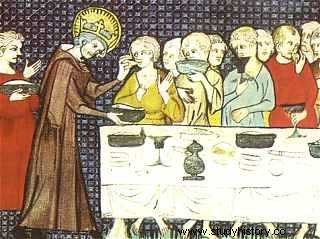
A very Christian king
His sense of justice and the righteousness of his judgment made Saint Louis chosen as arbiter in the conflicts between kings and princes. When he was reproached for his excessive generosity towards the poorest, he contented himself with replying:"If I sometimes spend a lot of money, I would rather do it in alms for the love of God than for my frivolities and worldly things. His desire to uphold divine law sometimes took on less sympathetic aspects:while one can wholeheartedly approve that he banned duels throughout his domain, it is more difficult to accept the cruel measures which he took against the Jews, whom he ordered to be expelled from the kingdom, heretics, whom he condemned to be burned alive, and blasphemers, whose tongues he pierced with a hot iron. Joinville relates on this subject that in 1251, the king, who was then on a crusade in Palestine, ordered that a Parisian goldsmith be put in the pillory (a post surmounted by a wheel on which the condemned man was exposed):he was reported a conversation in which this man had outraged the name of God. Children under ten guilty of the same offense were whipped in the public square and a reward was offered to those who denounced the culprits. Although he approved of the action of Saint Louis, the pope himself sometimes found this cruel justice excessive and, in 1268, he invited the king of France to show clemency. But his fidelity to Christianity, his exemplary life, the efforts he deployed to snatch the tomb of Christ from the Saracens earned him his canonization in 1297.
The Sainte-Chapelle
Saint Louis, like many men of his time, placed great importance on relics. This term designates the bones of a saint or the objects that belonged to him and to which the Church authorized worship. In 1239, the king bought from Venetian merchants, for a considerable sum, the crown of thorns that Christ would have worn at the time of his Passion. To house this relic, Saint Louis asked Pierre de Montreuil to build an exceptional building:this was the Sainte-Chapelle. The vault rests on a ribbed stone framework; the framework is thin enough so that the ground is not encumbered by the fallout of the pillars. The walls, which no longer support any weight, are entirely covered with very beautiful stained glass windows. It is a magnificent application of the principles of Gothic architecture.

A prosperous kingdom
In the middle of the 13th century, the France of Blanche de Castille and Louis IX was enjoying undeniable prosperity. The resources of his agriculture allowed him to ignore the famine. All major trade routes passed through the Capetian kingdom. The goods produced in Northern Europe or which were brought by Italian merchants to Flanders and especially to Champagne were exchanged during the annual fairs:there are no less than six fairs for Champagne alone. Around these commercial crossroads were built active cities. The University of Paris, which is the greatest intellectual center of Christianity, also contributes, in its field, to the exceptional influence of France in Europe in the 13th century. Radiation as evidenced by the spread of the French language:with Latin, it is the only language that is understood almost everywhere in Europe. But the prestige of France was due, in large part, to that with which the king's name was haloed within its States as well as beyond its borders.
